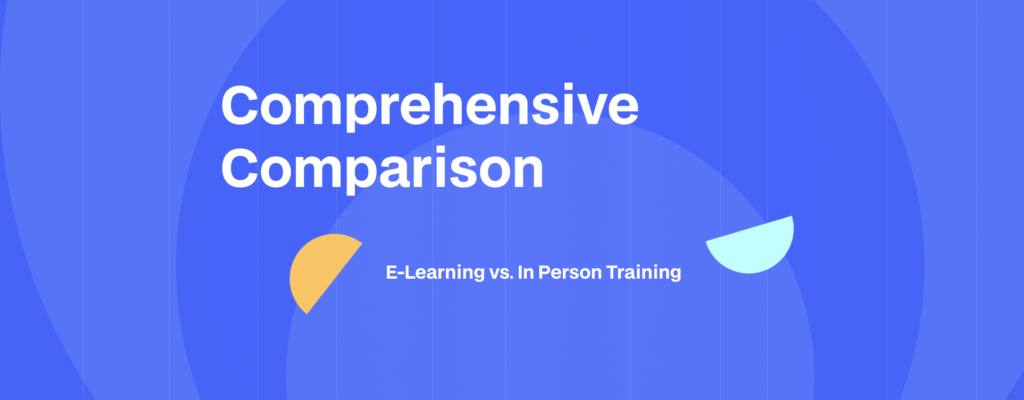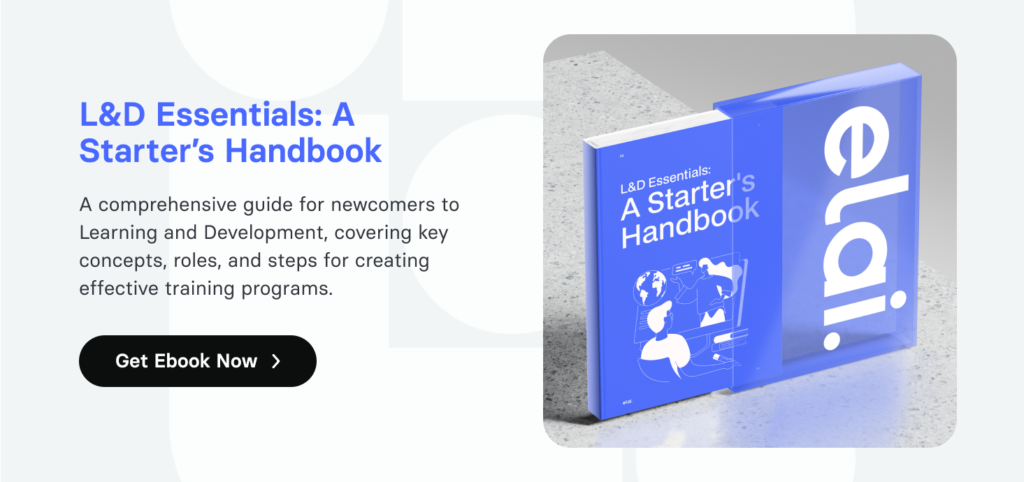E-learning or in-person training? It is extremely hard to choose between these two primary methods of delivering education. E-learning training and other types of online learning are based on digital technologies while conveying educational content. On the other hand, in person training involves face-to-face interactions in a real-world learning setting. In this article, we will conduct an ultimate comparison of both methods, exploring their primary advantages and disadvantages to figure out what the best option is.
While comparing the elearning training and in-person training benefits, we observe some drawbacks as well such as limited flexibility, learners’ convenience, knowledge retention rate, and expense ratio. Let’s dive into this in-person training vs online training research to find the answer to the question of life and death: what method is the most effective technique?
The Power of E-Learning
The corporate education is constantly evolving. This continuous process generates a high demand for seeking new alternative approaches to training and learning. This is where online learning comes in handy.
Tired of boring learning sessions where no one looks engaged and motivated? E-learning training is the right solution for those who value accessibility and flexibility. Since the workforce consists of different members with various needs, including generational particularities, diverse attention spans and learning styles, or even special needs, it is important to allow learners to access educational content anytime from anywhere. Take a look at the advantages of implementing learning modules into internal training programs:
- Accessibility: online training can be watched and rewatched anytime from any location. They are easy to share and update in case the information is outdated. Also, subtitles are particularly beneficial for individuals with disabilities. The produced learning content can be localized according to the country or region where employees live. The professionals have the flexibility to integrate learning into their daily lives and learn at their own pace.
- Cost-Effectiveness: Compared to traditional in-person training, e-learning is simply cheaper as there is no need to hire speakers, rent accommodations such as classrooms, and prepare resource materials.
- Personalized Learning: The facilitators can develop customized learning paths that fit different learning styles or even personalize each training chunk according to specific employee’s needs and pain points. This is the right way to make learners feel valued, supported, and respected, and obviously, it boosts knowledge retention rates.
- Scalability: E-learning training makers such as Elai.io facilitate multilingual training course creation in bulk. It opens up the learning possibilities for a large number of employees or students simultaneously from diverse backgrounds and locations.
- Interactivity: Online learning makes education more captivating with interactive activities such as quizzes and clickable buttons, engaging animations, and talking digital presenters. Additionally, you can add the required media, music, and screencasts for a more fascinating learning experience.

After having taken into account the pros of online learning, the next step is to select the most suitable online learning maker for crafting your training. Elai.io is an AI-driven video editing software for making interactive training content. Since its interface is convenient even for beginners and is very intuitive, this all-in-one tool includes everything you need for building engaging learning experiences. Check out TOP Elai.io’s features:
- 80+ AI-driven digital presenters
- 75+ languages supported for AI narration
- Wide selection of tailored video templates
- Interactive videos with quizzes and clickable buttons
- SCORM export
- Screen-recording option
- API for course generation in bulk
- Personalized video creation through variables
- Extensive media library
- AI Storyboard for scriptwriting
- Animated elements and more!
In-Person Training: The Human Touch
Nevertheless the above-mentioned advantages of online learning, in person personal training offer certain benefits as well. One unique aspect that can not be easily replicated in virtual environments is the human touch during face-to-face interactions. While receiving new knowledge, it is crucial to get instant feedback from the learners and vice versa the employees can address the questions to enhance overall understanding. This advantage sets stronger relationships between the speaker and the audience, builds trust encourages active participation. However, in person training can also have limitations:
- Limited Accessibility: In-person training all the participants to travel to a specific location. It might limit participation for those in remote areas and cause mobility challenges. Such events involve extra expenses for learners, including transportation, accommodation, etc. In addition, some of the participants might have special needs or disabilities making it impossible for them to attend the training and gain knowledge. Also, the success of training sessions might depend on adverse weather conditions.
- Time Constraints: Scheduling and coordinating events can be difficult, especially for large groups or those with busy schedules. It offers less flexibility compared to online learning, as participants must be present at a specific time and place.
- Higher Costs: In-person training involves additional costs for renting venues, catering, equipment, and other logistical arrangements.
- Amenities: Some type of training like in-person cyber security training requires additional equipment to showcase the practical application of the knowledge.
Although in-person training offers valuable interpersonal opportunities and networking, it’s important to consider its limitations while choosing the most suitable training method for your organization.
The Battleground: In-Person Training vs Online Learning
After having conducted a comparative analysis, it is clear that in the world of corporate education the training, first and foremost, must be effective and accessible. Online learning offers several advantages, including accessibility, cost-effectiveness, personalization, scalability, and interactivity, whereas in-person training provides a human touch, allowing real-time feedback, and discussions. While comparing online vs in-person training, we have highlighted that in-person training has more limitations.
However, the best possible approach is a blend of both methods, letting employees learn the necessary knowledge at their own pace online, and then test that knowledge with in-person training for practical application and interaction. This hybrid approach creates a supportive environment for continuous collaborative learning.
Conclusion
Both e-learning and in-person training have their own pros and cons. The best approach is to implement a combination of e-learning and in-person training as a comprehensive and effective approach to learning. By leveraging the strengths of both modalities, organizations can create engaging, personalized, and efficient learning experiences that meet the diverse needs of their learners.
FAQ
What are in-person training benefits?
In-person training provides a human touch promoting face-to-face interactions and fostering deeper engagement and connection among participants.
What is more effective: online training vs in-person training?
The combination of both methods leads to building a supportive, captivating, and efficient learning environment, boosting learners’ knowledge retention and engagement rate.

